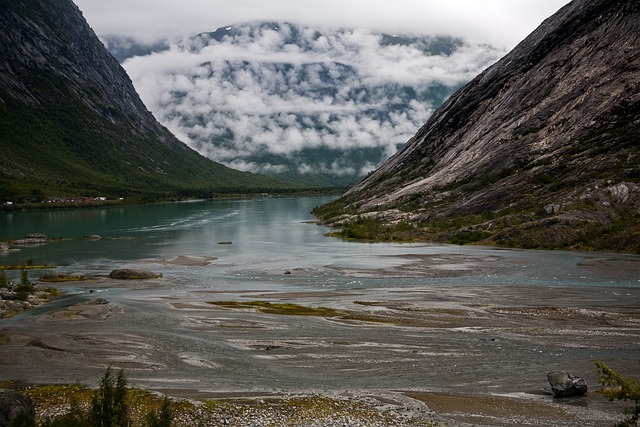Norway is renowned for its breathtaking natural landscapes, and the Norwegian fjords stand out as one of the country’s most awe-inspiring highlights. These deep, narrow, and elongated sea or lake gulfs, flanked by towering cliffs and rugged mountains, not only create stunning visual spectacles but also provide a wealth of outdoor activities and cultural experiences for travelers. If you are considering a trip to Norway, exploring the fjords should undoubtedly be at the top of your itinerary. This blog post will delve into the enchanting world of the Norwegian fjords, offering insights into their geography, history, best times to visit, and activities to enjoy along these majestic waterways.
What are Fjords?
Fjords are formed through the erosion of land by glacial activity. During the last Ice Age, glaciers carved deep valleys, and as they receded, they filled with seawater, creating the stunning waterways we see today. The contrasting landscapes of steep cliffs and serene waters create one of the most iconic images of Norway.

Notable Norwegian Fjords
Norway is home to some of the most beautiful fjords in the world. Here are a few that should not be missed:
- Geirangerfjord: A UNESCO World Heritage site, Geirangerfjord is famed for its lush green landscapes and magnificent waterfalls, such as the Seven Sisters and the Suitor. It’s ideal for hiking and offers breathtaking viewpoints such as Dalsnibba and Flydalsjuvet.
- Nærøyfjord: Also a UNESCO World Heritage site, Nærøyfjord is considered one of the narrowest fjords in the world. With its steep mountainsides and serene waters, it provides an intimate experience with nature. The fjord is easily navigable by boat, allowing visitors to soak in the views.
- Sognefjord: Spanning over 200 kilometers, Sognefjord is Norway’s longest and deepest fjord. The fjord is the gateway to numerous activities, including kayaking, fishing, and hiking, and is surrounded by a series of picturesque villages, each with its own unique charm.
- Hardangerfjord: Known for its blooming fruit trees and cascading waterfalls, Hardangerfjord is a favorite among tourists in the spring months. Adjacent to the fjord are beautiful hiking trails, including the trail leading to the famous Trolltunga rock formation.
- Lysefjord: Perhaps best known for the iconic Preikestolen (Pulpit Rock), Lysefjord offers outdoor enthusiasts a mix of adventure and stunning views. Hikers can embark on trails leading to viewpoints over the fjord, while boat tours allow for a more relaxed observation of the massive cliffs.
When to Visit
The ideal time to visit the Norwegian fjords largely depends on your preferred activities and the kind of experience you want:
- Summer (June to August): This is the peak season for travelers. The weather is mild, making it a great time for hiking, kayaking, and sightseeing. The long daylight hours and lush landscapes provide photo opportunities in abundance. Just be prepared for larger crowds.
- Fall (September to October): Autumn transforms the fjords as foliage changes color, offering an impressive spectrum of reds, yellows, and oranges. This is a quieter time to visit, ideal for those who prefer solitude in nature.
- Winter (November to March): While temperatures drop, a winter trip allows you to see the fjords in a magical landscape. Snow-covered peaks and frozen waterfalls create a serene, otherworldly atmosphere. Winter activities like snowshoeing and skiing are popular, especially in regions close to the fjords.
- Spring (April to May): Spring heralds the blooming of flowers and the thawing of the fjords. It’s an excellent time to witness waterfalls in full flow and to experience fewer tourists.
How to Explore the Fjords
Exploring the fjords can be done in a variety of ways, offering visitors a range of experiences:
By Boat
Taking a cruise through the fjords is one of the most popular ways to experience their natural beauty. Several tour operators offer boat trips ranging from short, scenic excursions to multi-day cruises that allow for in-depth exploration. Icons such as the Geirangerfjord and Nærøyfjord are best appreciated from the water, where you can observe the majestic cliffs and waterfalls up close.
By Kayak
For adventure seekers, kayaking provides an immersive way to experience the fjords. Paddle through the serene waters surrounded by towering mountains and cliffs. Guided kayaking tours come highly recommended for those unfamiliar with the area, as local guides can enhance your experience with their knowledge of the region.
By Car
Driving along Norway’s scenic coastal roads offers an appealing option for self-driven exploration. The National Tourist Routes encompass some of the country’s most stunning panoramas. Highlights include landmarks like the Atlantic Road and the Trollstigen (Troll’s Road), which takes you on winding bends over steep mountains.
By Hiking
If hiking and outdoor activities are your passion, the fjords offer plenty of trails suitable for all abilities. Famous hikes like the trek to Preikestolen and Kjeragbolten provide breathtaking views of the fjords from above. Many lesser-known trails surround the fjords, allowing you to escape the crowds and explore the beautiful landscapes at your own pace.
Through Local Culture
In addition to the natural beauty, the fjords are steeped in culture and history. Explore charming fishing villages, learn about local traditions, and indulge in fresh seafood. Museums, galleries, and cultural experiences along the fjords enrich the travel experience. Be sure to sample traditional dishes like “raspeballer” (potato dumplings) or “rakfisk” (fermented fish).

Practical Tips for Visiting the Fjords
- Stay Weather Prepared: Weather in Norway can be unpredictable. Pack layers and waterproof clothing to ensure that you’re comfortable, no matter what conditions come your way.
- Accommodations: There are a variety of accommodation options in the region, ranging from hotels and guesthouses to cozy cabins. Booking in advance, particularly during the summer months, is recommended.
- Transportation: While it is possible to navigate by public transport, renting a car provides flexibility and the opportunity to explore less accessible areas.
- Respect Nature: The Norwegian fjords are pristine environments home to diverse wildlife and ecosystems. Follow leave-no-trace principles and be respectful of the local environment.
The Norwegian fjords are a treasure of natural beauty, adventure, and cultural richness. Whether you choose to cruise along their waters, hike their towering peaks, or simply soak in the serene landscapes, the fjords offer a unique experience that will leave a lasting impression. Embrace the charm of Norway, and set out on a journey to discover the breathtaking fjords that define this incredible country—an adventure awaits you at every turn!





